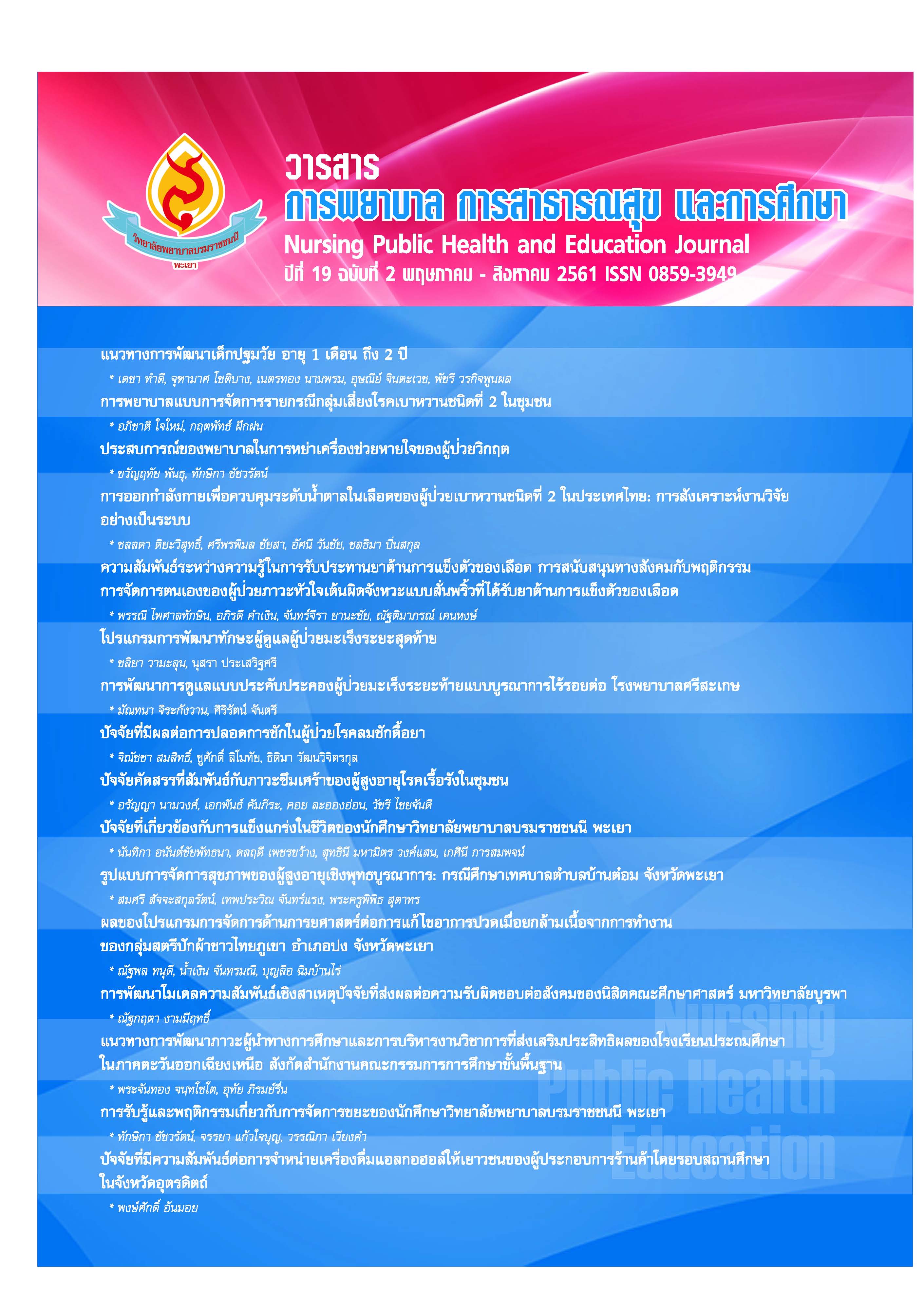ปัจจัยที่มีผลต่อการปลอดการชักในผู้ป่วยโรคลมชักดื้อยา
คำสำคัญ:
โรคลมชัก, โรคลมชักดื้อยา, การควบคุมการชัก, ปัจจัย, การปลอดการชัก, epilepsy, drugresistant epilepsy, seizure control, remission, factorsบทคัดย่อ
การใช้ยากันชักเป็นแนวทางการรักษาหลักสำหรับโรคลมชักแต่มีผู้ป่วยส่วนหนึ่งที่ไม่ตอบสนองต่อการใช้ยาหรือคือเกิดการดื้อยาการศึกษาแบบภาคตัดขวางย้อนหลังนี้มีวัตถุประสงค์เพื่อศึกษาปัจจัยที่อาจมีผลต่อการปลอดการชัก 12 เดือนในผู้ป่วยโรคลมชักดื้อยา ศึกษาในผู้ป่วยโรคลมชักดื้อยาที่อายุมากกว่า 18 ปี ที่มารับการรักษา ณ คลินิกโรคลมชัก โรงพยาบาลจุฬาลงกรณ์ สภากาชาดไทย ต่อเนื่องอย่างน้อย 24 เดือน จำนวน 161 คน รวบรวมข้อมูลที่เกี่ยวข้องจากเวชระเบียนร่วมกับการสัมภาษณ์ ผลการศึกษาพบว่า ผู้ป่วยส่วนใหญ่เป็นเพศหญิง 95 คน (ร้อยละ 59) อายุเฉลี่ย 39.9+10.3 ปี มีระยะเวลาการเป็นโรคลมชัก 25.7±10.9 ปีมีผู้ป่วยดื้อยาที่ควบคุมการชักไม่ได้หรือคือผู้ป่วยที่ยังมีอาการชักอย่างน้อย 1 ครั้งภายใน 12 เดือนก่อนหน้าวันที่เก็บข้อมูล จำนวน 108 คน (ร้อยละ 67.1) เมื่อเปรียบเทียบกับกลุ่มที่ปลอดการชัก 12 เดือน พบว่าทั้งสองกลุ่มมีอายุ เพศ อายุที่เกิดการชักครั้งแรกและระยะเวลาที่เป็นโรคลมชักไม่แตกต่างกันอย่างมีนัยสำคัญทางสถิติเมื่อวิเคราะห์ถดถอยโลจิสติกส์พบว่าปัจจัยที่มีความสัมพันธ์กับการปลอดการชัก12 เดือน คือ จำนวนยากันชักที่เคยได้รับและการได้รับการผ่าตัด โดยกลุ่มผู้ป่วยที่มีจำนวนยากันชักที่เคยได้รับตั้งแต่ 4 รายการขึ้นไป มีโอกาสปลอดชัก 12 เดือนน้อยกว่ากลุ่มที่ได้รับน้อยกว่า 4 รายการ (OR=0.21, 95%CI 0.09-0.51) และผู้ป่วยที่ได้รับการผ่าตัดมีโอกาสปลอดชัก 12 เดือนมากกว่ากลุ่มที่ไม่ได้รับการผ่าตัด (OR=8.42, 95%CI 2.09–33.86) การศึกษานี้เน้นให้เห็นปัญหาการควบคุมการชักไม่ได้ในผู้ป่วยโรคลมชักดื้อยา ปัจจัยที่มีความสัมพันธ์กับการปลอดการชักในผู้ป่วยกลุ่มนี้ได้แก่ ประวัติการรักษาด้วยการผ่าตัดและจำนวนยากันชักที่เคยได้รับ
Factors Affecting Seizure Remission in Patients with DrugResistant Epilepsy
Antiepileptic drugs (AEDs) are mainstay of epilepsy treatment. However, there is a significant proportion of patients who do not respond to AEDs or patients with drug resistant epilepsy. This retrospective cross-sectional study aimed to identify factors affecting 12-month seizure remission in patients with drug resistant epilepsy.A total of 161 drug-resistant epileptic patients aged 18 and above who had been followed up at the epilepsy clinic in King Chulalongkorn Memorial Hospital for at least 24 months were included in this study. Pertinent clinical information were extracted from medical records and patient interview. The majority of the patients were women (n=95, 59%). The average age was 39.3±10.3 years old and the average duration of epilepsy was 25.7±10.9 years.There were 108 patients (67.1%) with uncontrolled epilepsy or patients who had at least 1 seizure within 12 months prior to their clinic visit.When compared with a group of patients who achieved a 12-month remission, there were no statistically difference in terms of age, sex, age of seizure onset and duration of epilepsy. Logistic regression analysis revealed that factors associated with 12-month seizure remission in patients with drug resistant epilepsy were number of past ineffective AEDs and history of epilepsy surgery. The odds of patients with > 4 past ineffective AEDs achieving 12-month remission was less than those who had <4 past ineffective AEDs (OR=0.21, 95% CI 0.09-0.51). Patients with history of epilepsy surgery were significantly more likely to achieve 12-month remission than those who without (OR=8.42, 95% CI 2.09-33.86).This study highlights the magnitude of the problem of uncontrolled seizure in patients with drug resistant epilepsy. The main factors associated with seizure control inthese patients were history of epilepsy surgery and the number ofpast ineffective AEDs.
เอกสารอ้างอิง
สมาคมโรคลมชักแห่งประเทศไทย. (2559). แนวทางเวชปฏิบัติโรคลมชักสำหรับแพทย์. สืบค้นเมื่อ 19 พฤศจิกายน2560, จาก http://thaiepilepsysociety.com/wp-content/uploads/2016/11/แนวทางเวชปฏิบัติโรคลมชักสำหรับแพทย์_2015.pdf.
Bala, A., Szantroch, M., Gleinert, A., Rysz, A., &Marchel, A. (2016).Differences in quality of life of women and men with drug-resistant epilepsy in Poland.Epilepsy Behavior, 60, 94-98.
Callaghan, B., Schlesinger, M., Rodemer, W., Pollard, J., Hesdorffer, D., Allen Hauser, W., et al. (2011).Remission and relapse in a drug-resistant epilepsy population followed prospectively. Epilepsia, 52(3), 619-626.
Choi, H., Heiman, G., Pandis, D., Cantero, J., Resor, SR., Gilliam, FG., et al. (2008). Seizure remission and relapse in adults with intractable epilepsy: a cohort study. Epilepsia, 49(8), 1440-5.
Kwan, P., Arzimanoglou, A., Berg, A. T., Brodie, M. J., Allen Hauser, W., Mathern, G., et al. (2010). Definition of drug resistant epilepsy: consensus proposal by the ad hoc Task Force of the ILAE Commission on Therapeutic Strategies. Epilepsia, 51(6), 1069-1077.
Medcalc.(2018). Logistic regression.Retrieved January 30, 2018, from https://www.medcalc.org/manual/logistic_regression.php.
Morton, B., Richardson, A., & Duncan, S. (2006). Sudden unexpected death in epilepsy (SUDEP): don't ask, don't tell? Journal Neurology Neurosurgeryand Psychiatry, 77(2), 199-202.
Schiller, Y. (2009). Seizure relapse and development of drug resistance following long-term seizure remission.Archives of Neurology, 66(10), 1233-1239.
Tatro, DS. (2015). Drug interaction facts. St. Louis: Wolters Kluwer Health.
Tomson, T., Nashef, L., &Ryvlin, P. (2008).Sudden unexpected death in epilepsy: current knowledge and future directions. The Lancet Neurology, 7(11), 1021-1031.
World Health Organization. (2017, February) Epilepsy factsheet.Retrieved November8, 2017, from http://www.who.int/mediacentre/factsheets/fs999/en/.



